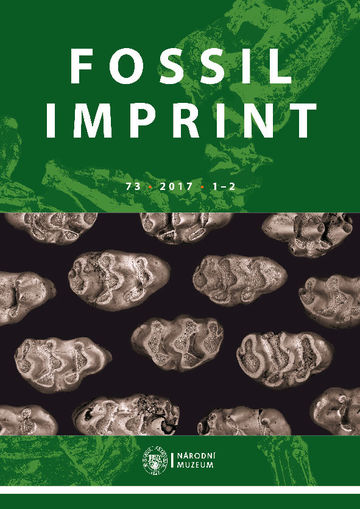
2017/73/1-2
ISSN : 2533-4050 (tisk), 2533-4069 (online)
Editor in Chief : Jiří Kvaček
Editor in Chief : Jiří Kvaček
Morphometric analysis of metacarpal and metatarsal bones of cave bears (Carnivora, Ursidae)
Gennadiy F. Baryshnikov, Andrey Yu. Puzachenko
For the first time, morphometric variation has been studied in metacarpal and metatarsal bones of all known taxa of cave bears, which belong to different molecular genetic groups (deningeri, kudarensis, spelaeus, and ingressus haplotypes). The examined material involves nearly three thousand…
Small mammal fauna in Europe during the second half of the Middle Pleistocene
Anastasia K. Markova, Andrey Yu. Puzachenko
Evolutionary changes in European small mammals during the second half of the Middle Pleistocene, from the Likhvin (Holsteinian, Hoxnian) Interglacial (MIS 11) to the beginning of the Mikulino (Eemian) Interglacial (MIS 5e), that is between 424 ka BP and 130 ka BP were traced. Trends in evolutionary…
Report on the discovery of fossil mares with preserved uteroplacenta from the Eocene of Germany
Jens Lorenz Franzen
I report on the discoveries of three pregnant mares from the middle Eocene of Germany that contain remains of fetuses still wrapped in the fossilized uteroplacenta. These are the first and up to now only discoveries of this kind. One specimen comes from the Eckfeld Maar (Eifel Mountains). It is 44…
A review of the Pleistocene dwarfed elephants from the Aegean islands, and their paleogeographic context
Sevket Sen
This paper provides a synthesis of the present knowledge on dwarfed endemic elephants from the Pleistocene of the south Aegean islands. Pleistocene elephants are quite well documented from Crete and Tilos, but with scarce remains on other islands. The systematics and affinities of these elephants…
Pleistocene mammal fauna of the Trlica locality, Montenegro
Alexandre K. Agadzhanyan, Inesa A. Vislobokova, Mikhail V. Shunkov, V. A. Ulyanov
The paper presents new evidence on the small and large mammal fauna from the Trlica locality, Montenegro, based on our records from the 2010 – 2014 excavations. It is shown that the lower layers of the locality correspond to the Early Pleistocene, and the upper layers are dated as the beginning of…
Light and shadows in the evolution of South European stenonoid horses
Maria Rita Palombo, Maria Teresa Alberdi
The appearance of monodactyl equids in Eurasia and their dispersal towards South Europe is a significant event that marks the beginning of the Quaternary period. During the Pleistocene, horses were a common element in most European large mammal faunal assemblages, providing important…
Cricetidae (Rodentia, Mammalia) from the early Miocene site of els Casots (Vallès-Penedès Basin, Catalonia)
Sílvia Jovells-Vaqué, Montserrat Ginestí, Isaac Casanovas-Vilar
Els Casots is an extremely rich early Miocene site located in the Vallès-Penedès Basin (Catalonia, Spain) that has provided both micro- and macrovertebrates. However, the small mammals have been poorly studied. In this work we describe the cricetid fauna from els Casots and provide further insights…
A detailed description of Cricetodon hungaricus (Kordos, 1986) (Rodentia, Mammalia) from Hasznos (N. Hungary, Nógrád County)
János Hír
The large-sized cricetid rodents (Tribe Cricetodontini) are of primary importance in the biostratigraphy of the Middle Miocene in Hungary. Cricetodon hungaricus is especially remarkable due to its original morphology and stratigraphic range. New excavations in the type locality of the species,…
Arsinoitherium (Embrithopoda) and other large mammals and plants from the Oligocene of Tunisia
Martin Pickford
Palaeogene large mammals are poorly represented in Tunisia, in contrast to Morocco, Algeria, Libya and Egypt, where abundant and diverse faunas are known. Oligocene proboscideans have been recorded from four localities in Tunisia (Djebel Bou Gobrine, Oued Bazina, Bled Mellaha and Djebel Touila) but…
Revised floral and faunal assemblages from Late Pleistocene deposits of the Gánovce-Hrádok Neanderthal site – biostratigraphic and palaeoecological implications
Martin Sabol, Diana Slyšková, Silvia Bodoriková, Tomáš Čejka, Andrej Čerňanský, Martin Ivanov, Peter Joniak, Marianna Kováčová, Csaba Tóth
Revisory research of floral and animal assemblages from the Neanderthal site of Gánovce-Hrádok confirmed the previous stratigraphic division of the travertine mound to five horizons on the basis of different petrological and palaeontological contents, indicating climatic and palaeoenvironmental…
Early Late Miocene Murine Rodents from the Upper Part of the Nagri Formation, Siwalik Group, Pakistan, with a new fossil calibration point for the Tribe Apodemurini (Apodemus/Tokudaia)
Yuri Kimura, Lawrence J. Flynn, Louis L. Jacobs
The early late Miocene is an interval of increased diversification for murine rodents. Whereas the genus Progonomys became widespread throughout Eurasia by 10 Ma, it appears from the known paleontological record that southern Asia is the arena of evolution and diversification at the base of the…
Eomys helveticus n. sp. and Eomys schluneggeri n. sp., two new small eomyids of the Chattian (MP 25/MP 26) subalpine Lower Freshwater Molasse of Switzerland
Burkart Engesser, Daniel Kälin
Two new small Eomys species of the Chattian Lower Freshwater Molasse of Central Switzerland are described. Eomys helveticus n. sp. and Eomys schluneggeri n. sp. from the localities Rigi 1 and Rigi 2 are characterized by their relatively small dimensions and the metalophid of the lower molars not…
